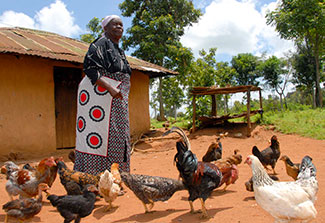Experts urge global adoption of One Health approach
March / April 2021 | Volume 20 Number 2

Photo by Boniface Mwangi/Africa Knows
A global One Health approach to disease surveillance and
pandemic response should include low-resource settings
where people and animals often live in close proximity,
scientists said in a recent workshop.
By Susan Scutti
The theme of interdependence dominated discussions at a recent workshop on One Health, which aims to improve the well-being of people, animals and the environment by integrating the efforts of multiple disciplines. “COVID-19 reminds us that no country acting alone can respond effectively to human, animal or environmental health threats in a globalized world,” said Dr. Eric Goosby in his keynote address at the event hosted by the National Academies of Science, Engineering and Medicine.
The current paradigm of pandemic management is “typically reactive” with nations and health organizations working in silos - an approach that leads to “breathtaking” economic and human losses, observed Goosby, who is professor of medicine at the University of California, San Francisco. Meanwhile, 60% of human diseases arise from pathogens in animals, and, in the U.S. alone, animals are consuming two times the medically important antibiotics as people. Within the coming decades, scientists project that spillover animal-to-human viral events plus antimicrobial resistance could result in huge death tolls. If nations collaborated to implement a One Health approach, the globe could better prevent, prepare for and respond to inevitable future outbreaks of infectious disease, said Goosby, who also serves on Fogarty’s advisory board.
Lower-resource regions often have little surveillance capacity, which makes it especially difficult for them to identify and respond to outbreaks, Goosby explained. He envisions an effective, sustainable surveillance system that would function as a rolodex of talent that is regionally identified. A team could mobilize in hours after an alarm is raised “to assess and report back and initiate an infusion of resources.” While creating “a blanket of surveillance that covers everything” is unrealistic, Goosby said better use of sophisticated technologies that utilize cellphone, purchasing pattern and human movement data could help anticipate threats. The WHO may be best suited for identifying unmet needs, yet filling those needs must be a shared responsibility, he said. “For so many countries, the option of acting alone and expecting that to achieve what's needed is not realistic.”
The workshop also featured experts from various academies and international institutions who explored research opportunities, collaboration mechanisms, community engagement strategies, educational opportunities and policies to operationalize One Health principles. A panel of experts that examined challenges to integrating policy within health systems included Dr. John Balbus, of the NIH’s National Institute of Environmental Health Sciences, and Dr. Christopher Braden, of the CDC.
Public health interventions dealing with wildlife or land management or ecosystem manipulation - as opposed to vaccine or drug interventions - are often met with skepticism, said Balbus. “We have to build-in metrics and evaluation to demonstrate that these methods are successful.” Another stumbling block: One Health programs in the U.S. government have not been “mainstreamed” and currently function as policy islands. One Health is not just zoonotic crossover and pandemics, it also includes the less-studied ocean, fungal and microbial worlds, Balbus noted.
Examining national coordination from another angle, Braden emphasized the need for technological modernization to help scientists collaborate across silos. Layering data so that agencies and researchers can see “what's being collected in the animal health sector, the human health sector and the environmental sector - that's where we struggle. We work with rather antiquated systems and ideas about how data and surveillance can work,” he said. Use of modern system architectures, new data sources and sophisticated integration tools could address these issues and also improve data interactions in the cloud.
Finally, participants explored better ways to prepare a One Health workforce. Academies need to “work backwards” to provide a needs-based and critical competency-based education, according to Dr. Lonnie King, dean emeritus of veterinary medicine at Ohio State University. Graduates need to have multidisciplinary knowledge and the ability to form effective partnerships, King said. “Relationship-building is the number one skill for this decade.”
More Information
-
Systematizing the One Health Approach in Preparedness and Response Efforts for Infectious Disease Outbreak [Video] via the NASEM Health and Medicine Division YouTube Channel
-
Profile: Eric Goosby, MD, via University of California, San Francisco
-
Profile: John Balbus, MD, MPH via NIH's National Institute of Environmental Health Sciences (NIEHS)
-
Profile: Christopher Braden, MD [PDF] via the U.S. Centers for Disease Control and Prevention (CDC)
-
Profile: Lonnie J. King, DVM, MS, MPA, Diplomate ACVPM via the Ohio State University
- One Health news, resources and funding for global health researchers
To view Adobe PDF files,
download current, free accessible plug-ins from Adobe's website.
Related Global Health Research Topics